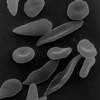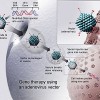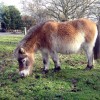Site Topics

Malaria Mystery: SOLVED
Dec 15th
Normal and Sickled Red Blood Cells
While scientists have long known that carriers for Sickle Cell Trait are more resistant to Malaria infection, the mechanism by which protection is conferred has not been well understood—until now. Scientists at Heidelberg University used an electron microscope to observe what happens when the parasite that causes Malaria in humans, Plasmodium falciparum, infects red blood cells containing both healthy and mutant hemoglobin.
Scientists noticed that in red blood cells with healthy hemoglobin, the parasite hijacks the actin cytoskeleton to transport its own “adhesin” protein to the cell membrane. The adhesin, also called Plasmodium falciparum Erythrocyte Membrane Protein 1 More >

Merry Christmas to Hemophilia Patients
Dec 15th
Gene therapy is a technique that offers the potential to replace defective copies of genes in any genetic disease with an intact version. While the idea of this treatment sounds alluring, the actual practice of it is a whole other story. There are a few drawbacks to this technique that must be considered, including the potential risk of an immune response because the gene is inserted with the use of a virus, which the immune system will see as foreign. Also, most patients so far have needed multiple treatments over the course of their lifetime, estimating to cost much more More >

Cancer Overtreatment. When the solution is worse than the problem.
Dec 13th
We often focus on cancers that are lethal, and especially those that can’t be treated, and for obvious reasons. This week, the National Institutes of Health addressed a different concern- that sometimes a cancer that isn’t life threatening is best left alone. In this case, it is prostate cancer, which affects about 30 to 40 percent of men over 50. About 240,000 men are diagnosed with prostate cancer a year, and over 30,000 die of the disease – so it is far from being rare or harmless for many. However, over half of prostate cancers are localized and many will More >

Ancient cave paintings, fact or fiction? Prehistoric Horse DNA Holds the Key
Nov 29th
Pony with Pangare markings
Before the dawn of the written language, prehistoric humans began recording events from their daily lives and environment on the walls of their local caves. Now many of these cave paintings are treasured, priceless works of ancient history and art. Many different animals are represented in these paintings and about a third of them are horses. [1]
There has been much speculation about exactly which horse breeds existed when the painting of cave walls began about 25,000 years ago. Some of the types predicted included bays, grays and horses with dun colored coats with pangaré markings (tan coat with More >

Trying to unlock a new door…..
Nov 28th
How is drug development moving along? Well, this is a very good question for we are still plagued by some elusive diseases, cancer for example. There have been many drugs developed targeting proteins involved in disease states some of which have proven to be quite effective. However today the steam engine for identifying drug targets to proteins involved in disease is becoming ever more difficult. Apparently over the past decade or so, the number of new drugs targeted toward disease has declined. This is primarily due to the fact that developing new medicine has become more difficult to do. It More >

Harnessing the power of bioinformatics in cancer research
Nov 22nd
One of the biggest challenges facing cancer researchers is that the disease varies so much from person to person. Even the same type of cancer – lung, brain, breast, colon, and so on – can be subtly different. This means that a therapy that works well in one patient may have no effect in another.
So researchers in the UK brought in the big guns – bioinformatics.
Cancer Research UK has set up seven British centers to start collecting 9,000 tumor samples from a wide range of cancer patients to create a DNA database. Researchers will extract DNA from these tumors and More >

One Size Does Not Fit All
Nov 11th
In 1994, there were more than 2.2 million serious medical cases, and over 100,000 deaths from negative reactions to prescribed drugs. (NCBI) These numbers have made adverse drug reactions one of the leading causes of hospitalization and deaths in the US. Currently, there is no easy way to determine how a patient is going to respond to a medication, so pharmaceutical companies are relying on a “one size fits all” policy. But as we can see with the amount of hospitalizations and deaths each year, there has to be a better way. One area that is shedding hope on this More >
Bacteria and Antibiotics
Nov 11th
There are a number of various types of bacteria that naturally exist in our bodies and help us in different ways. Unfortunately, bacteria get a bad reputation. Most people are unaware of how important these organisms are. It is estimated that in a healthy person, there are about ten times as many bacteria cells as human cells! Fluctuations in the level of these bacterial cells can lead to problems such as digestive issues, skin problems, obesity, and more. It is important to think about the way bacteria cells function and evolve when we consider our own health.
If an individual becomes More >

Compulsive Hoarding
Nov 10th
Many of us have seen the variety of shows lately on TV that highlight a behavior known as compulsive hoarding. Shows like “Hoarders” and “Hoarding: Buried Alive” give insight into the severity of this condition. On the shows, there is a person living in conditions that are, in no other words, unlivable. Things such as newspapers, magazines, clothes, boxes, knick-knacks, and food are piled in every available space in the home making walking through the home hazardous.
So what exactly is this condition that is being portrayed on these TV shows? Compulsive Hoarding is an anxiety disorder that affects as many More >

The Secrets of Butterflies
Nov 8th
Butterflies are a timeless symbol of beauty and serenity, with their sweet graceful fluttering is enjoyed by people around the globe. But to “non-people,” or hungry animals, they are more often a source of food. Butterflies have almost no chance against birds and other faster predators. They tend to be slow flyers and many have vibrant colors that stand out in contrast to the flowers they choose to collect nectar from.
So why have they not succumbed to the pressures of natural selection? They are much tougher than they appear. Butterflies have three dominant defense mechanisms that have kept them safe More >
